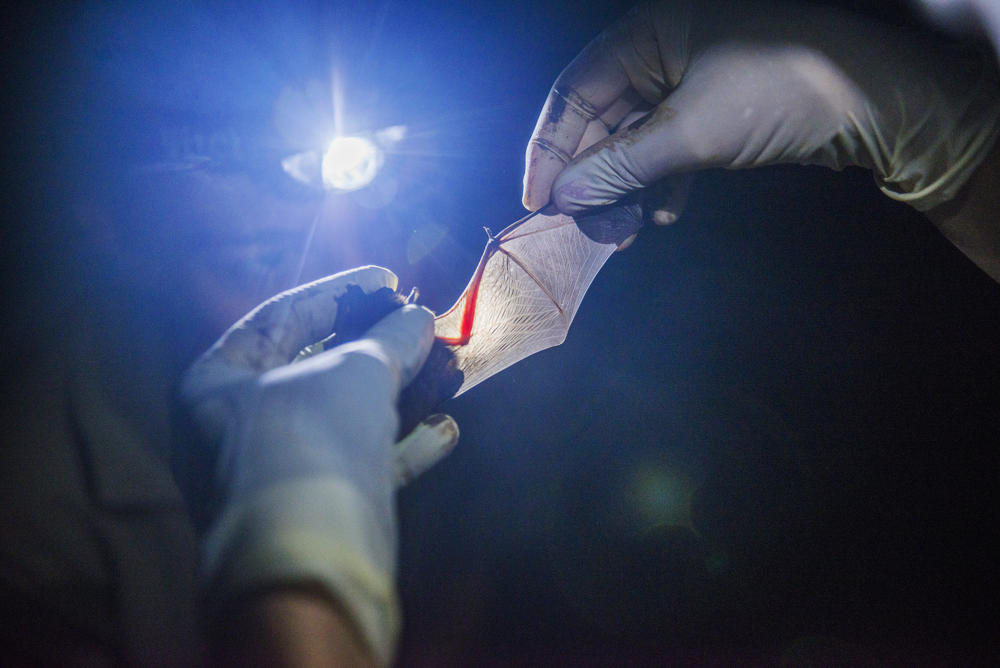
Section Branding
Header Content
Keeping An Eye On Bats As Their Numbers Drop
Primary Content

Believe it or not, there are some people in the South who love watching bats the way others love watching birds.
If that’s you, and you’ve noticed fewer bats in recent years, know you aren’t imagining things. And even if you find bats kind of creepy, experts say you might change your tune once the bugs they eat become pests in increasing numbers in the Summer.
That’s because bats in the South are under pressure.
The first ever survey of bats at the Ocmulgee National Monument is part of the larger effort by the Georgia Department of Natural Resources to know establish a baseline for bat numbers before pressures do them in. The DNR only started looking hard at bats around six years ago when a disease started wiping out whole caves worth of them in the Northeast.
“You know, we knew that White Nose Syndrome was coming. It was sad, you could watch it spreading south,” said Jaclyn Beck, the DNR research coordinator leading the Ocmulgee survey.
On a recent evening, the sun was setting on Walnut Creek in the Ocmulgee National monument as Beck and another researcher, Rebekah Tuck, were stringing a huge net — 9 yards wide and 20 feet high, across the creek. It was a bat trap.
Tuck, left, and research coordinator Jaclyn Beck put the finishing touches on one of the mist net traps used to catch bats during the Ocmulgee National Monument bat survey. Photo by Grant Blankenship/Georgia Public Broadcasting
Mist netting like this, paired with acoustic surveys and cave searches, are the methods Beck and others use in North Georgia to get a good look at bat populations there. What they’ve seen isn’t good.
“Our populations have gone down 82% since we found white nose in Georgia,” Beck said.
Trina Morris is a non-game biologist with DNR. She says that 82% drop only started in 2013. But, it was mostly confined to one animal, the Tri-Color bat.
“We haven’t really focused on that species in the past, because it was really common,” Morris said.
White Nose Syndrome is changing that. The Tri-Color bat ranges from the caves of North Georgia down to Florida. Morris says Middle Georgia Tri-Colors may live here year-round or migrate north in the winter. That could make Middle Georgia an important Tri-Color refuge.
“It could be that we end up with only good populations of Tri-Color bats in the coastal plain of Georgia,” Morris said.
Researchers often use a batting glove on one hand to protect themselves while untangling bats from mist nets. They also as a rule have already been inoculated against Rabies, though research coordinator Jaclyn Beck says the idea that Rabies is widespread in bats is largely a myth. Photos by Grant Blankenship/Georgia Public Broadcasting
At the net site, a hooting owl was making the researchers antsy.
“Owls are bad news for bat,” Jaclyn Beck said. Turns out an owl can catch a bat on the wing.
So the researchers waited. The owl hooted again.
“No one’s impressed, owl,” said Sarah Sherburne, another one of the researchers.
Jaclyn Beck and Sarah Sherburne use a high powered spotlight to check the creek net for a bat. Photo by Grant Blankenship/Georgia Public Broadcasting
“Not even a bug,” Beck said as they walked back to their work station
So they waited some more.
There’s another bat Jaclyn Beck would have loved to have seen here, the Rafinesque Long Ear Bat.
“It’s ears are about the length of its body,” she said. “It looks like no other bat we have in Georgia.”
It’s rare, too, though that has nothing to do with White Nose Syndrome. Instead it’s the natural nesting sites for the Rafinesque Long Ear Bat that are the problem. It needs mature cypress or tupelo trees in deep swamps. There aren’t many of those left.
Sarah Sherburne and the third researchers, Rebekah Tuck, looked during the day for roosts that could be used for Rafinesque Long Ears.
After a few more checks, the researchers had success. There was a bat in the net across the creek.
Sherburne and Tuck quickly got in the water to untangle the bat.
“It’s going to take me a little bit, he’s pretty bad,” Sherburne said.
As badly as the animal was tangled, Tuck said they had to be careful.
“Their toes are so tiny you could dislocate them or like mess up a wing, so you have to be really gentle,” Tuck said.
Sarah Sherburne, left, and Rebekah Tuck work to free a female Evening Bat from a mist net strung across Walnut Creek in the Ocmulgee National Monument during the first ever bat survey there. Photo by Grant Blankenship/Georgia Public Broadcasting
They finally worked it loose. Back at their work stations they recorded the bat’s measurements. It was neither a Tri-Color nor a Rafinesque Long Ear, but an Evening Bat. It made a constant, ratcheting noise as they got started.
“So you can hear him, chirping away,” Beck said.
Turned out “he” was a “she”.
“So there’s a nipple in there pretty extended,” Beck said. “And she’s lactating right now.”
Which meant there were pups in a tree roost somewhere.
“Her wings are lovely,” Beck said. “She doesn’t have any scars or tears.”
Which meant she was in good health, too.
By the time they were done, it was time to check the nets again. They found another Evening Bat, another adult female. This one was more squirmy.
“Hey now, this is not how this is going to go down,” Rebekah Tuck said as she handled it.
Rebekah Tuck blows gently into the face of a female evening bat while handling it for scientific measurements. That’s a trick that often makes bats quit gnawing on researchers hands. Photo by Grant Blankenship/Georgia Public Broadcasting
She was lactating, too. So there was another set of pups somewhere.
By the end of the month of netting and searching, these two evening bats, plus a big brown bat the night after, were all the researchers caught. There were no Tri-Colors.
The researchers had wanted to extend the day time searches for the Rafinesque Long Ear to private property adjacent to the monument. But that might have to wait until the land in question gets folded into the Ocmulgee Monument property. That could be years away if it happens at all.
Still, as Jaclyn Beck helped finish up with the second Evening Bat, she saw a bright side.
“Babies are coming!” she exclaimed.
Despite knowing the pressures on bats elsewhere, these researchers were happy knowing there were new born bats out in the woods.
A female Evening Bat released after capture and measurement in the Ocmulgee National Monument bat survey. Photo by Grant Blankenship/Georgia Public Broadcasting
Bottom Content

